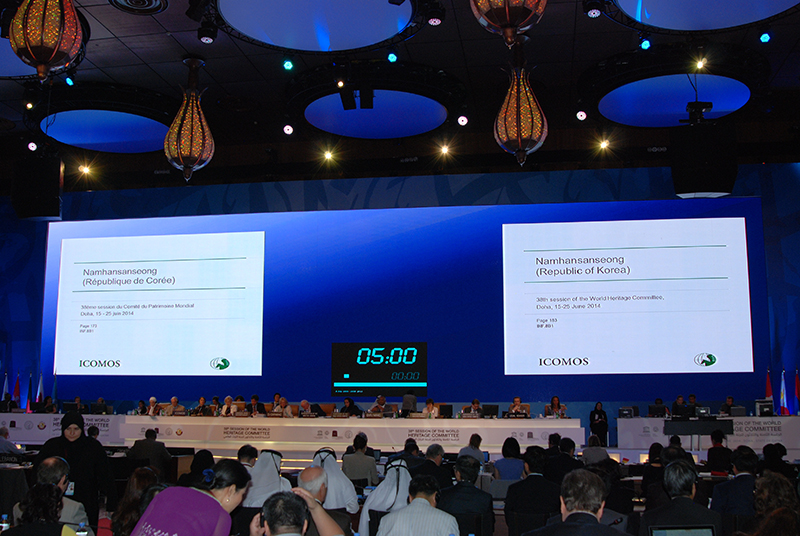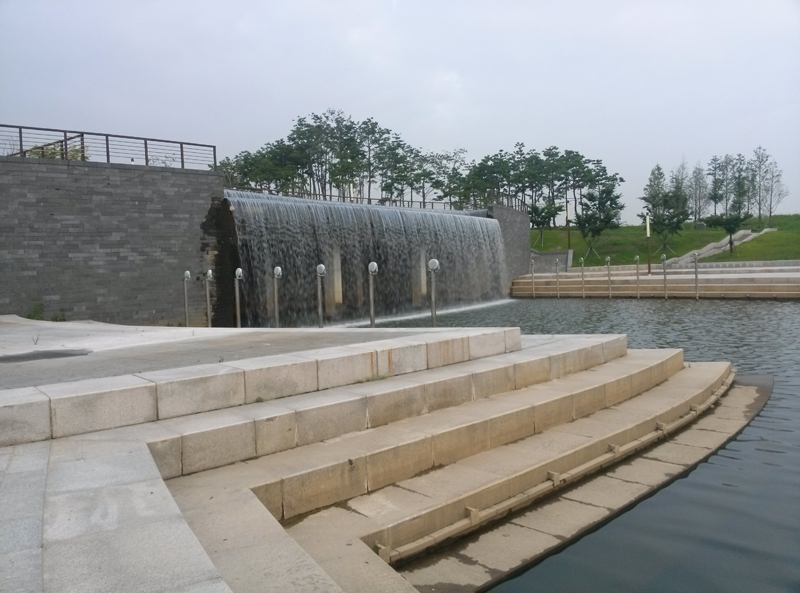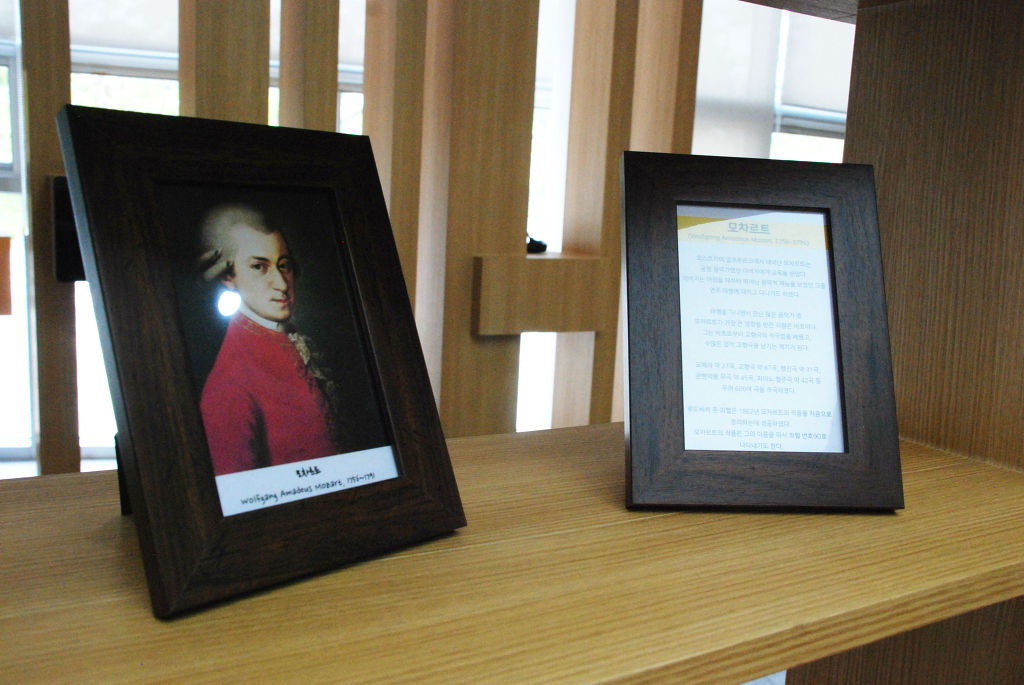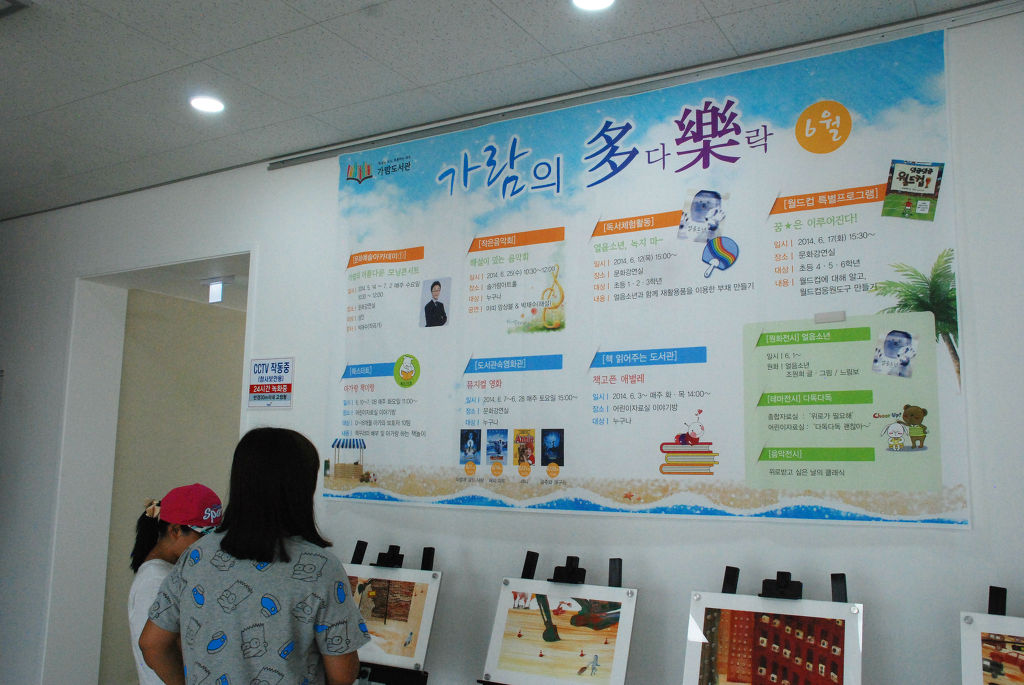38th session of World Heritage Committee announces on June 22 that Namhansanseong will finally be inscribed on World Heritage List
Joint efforts of Gyeonggi Province and Namhansanseong Culture & Tourism Initiative for inscription finally pay off
Gyeonggi Province completes mid and long-term development plan ‘to make the fortress an internationally-renowned tourist attraction’

◇The World Heritage Committee finally inscribed Namhansanseong on the World Heritage List at 9:35 am (15:35 Korea Time) on June 22 during the 38th session of the World Heritage Committee that took place at the Qatar National Convention Centre in Doha, Qatar. ⓒ Gyeonggi G-News
Located in Gyeonggi Province, Namhansanseong was selected as Korea’s 11th UNESCO World Cultural Heritage Site.
According to Gyeonggi Province, the World Heritage Committee finally inscribed Namhansanseong on the World Heritage List at 9:35 am (15:35 Korea time) on June 22 during the 38th session of the World Heritage Committee that took place at the Qatar National Convention Centre in Doha, Qatar.
It has been four years since a Korean cultural site was inscribed on the World Heritage List. The historic villages of Yangdong and Hahoe were inscribed in 2010. Korea now has 11 cultural heritage sites including Seokgulam and Bulguksa, Haeinsa Janggyeong Panjeon, Jongmyo Shrine (in 1995), Changdeok Palace, Suwon Hwaseong Fortress (1997), the historic remains of Gyeongju, Hwasun and the Ganghwa Dolmen Sites, (2000), Jeju Volcanic Island and Lava Tubes (2007), the Royal Tombs of the Joseon Dynasty (2009), and the historic villages of Yangdong and Hahoe.
The 38th session of the World Heritage Committee examined 40 sites (28 cultural sites, 9 natural sites, and 3 natural and cultural sites) out of 49 sites submitted for inscription. Nine sites were eliminated from nomination during an initial evaluation. Among the 40, Namhansanseong was examined as the 24th site, and officially inscribed.
As soon as the inscription of Namhansanseong on the World Heritage List was confirmed, Governor Gyeonggi Province Kim Moon-soo, who led the provincial delegation to the session, said during his appreciation speech to the World Heritage Committee that “I am so glad to see Namhansanseong taking another step towards a new future here today. The Republic of Korea and Gyeonggi Province will implement policies to preserve the site’s outstanding universal value to humanity based on strong protection schemes and budgetary support for Namhansanseong, a historic center of East Asia”.
The International Council on Monuments and Sites (ICOMOS), an advisory body to the World Heritage Committee, recommended Namhansanseong for inscription in its evaluation report last April. Thus, it was anticipated that Namhansanseong would be inscribed.

◇The 38th session of the World Heritage Committee took place on the morning of June 22 at the Qatar National Convention Centre in Doha, Qatar. ⓒ Gyeonggi G-News
□ Why did UNESCO inscribed Namhansanseong on the World Heritage List?
World Culture Heritage Sites are those that have the outstanding universal value. The World Heritage Committee has 10 different selection criteria to evaluate such outstanding universal value, and cultural sites must meet at least one of them.
According to the evaluation report by ICOMOS, Namhansanseong satisfied 2 selection criteria:
II) The site exhibits an important interchange of human values, over a span of time or within a cultural area of the world, on developments in architecture or technology, monumental arts, town-planning or landscape design.
IV) The site must be an outstanding example of a type of building, architectural or technological ensemble or landscape which illustrates significant stages in human history.
ICOMOS determined that Namhansanseong has world heritage value for the following reasons: 1) the fortress is a military site featuring a notable combination of weapon development and fortification technologies in the East Asian region, and is the only fortress city built as an emergency capital to protect the autonomy and independence of the Joseon Dynasty; and 2) it demonstrates significant development stages of fortification technologies from the 7th to 19th centuries through the construction of walls and defensive facilities incorporating natural geographic features.
Nanhansanseong has a facility named Yeojang in which soldiers could shelter while using rifles or bows, as well as Chongan, apertures for shooting, and a contravallation. The fortress changed in form according to the development of weapons from merely having a wall in its early stages.
Namhansanseong had Haenggung, a temporary palace, in its center with Jwajeon, a shrine on the left, and Usil, an altar. Nanhamsanseong also has a fortress gate which had been built based on the Fengshui of the Zhou Dynasty of China, referred to as Juryedonggwangogonggi. ICOMOS determined that this element satisfied selection criterion II, which stresses the exchange of human values.
In addition, Namhansanseong encompasses fortress remains over the years from the Unified Silla Dynasty of the 7th century to the Joseon Dynasty during the reigns of Injo, Sukjong, Yeongjo and Jeongjo. This demonstrates the development of fortification technologies over the years in one place, and satisfies selection criterion IV which requires the illustration of significant stages in human history.
ICOMOS also highly evaluated the following:
1) The property reflecting world heritage value has been well preserved through an effective legal protection scheme and the Namhansanseong Culture & Tourism Initiative, an integrated private organization dedicated to the protection and preservation of the site from a perspective of perfection.
2) The forms, designs, materials and functions as well as historic elements of the site are validated by diverse historical records including Samgulsagi, The Chronicles of Three States, in terms of authenticity.

◇ Governor Kim Moon-soo attends the 38th session of the World Heritage Committee. ⓒ Gyeonggi G-News
□ What does the inscription of Namhansanseong on the World Heritage List mean?
The inscription of Namhansanseong on the World Heritage List is of great significance because it denotes the international recognition of Namhansanseong for its outstanding universal value. With its inscription, Namhansanseong has gained international attention, and is expected to secure technological and financial support from the UNESCO World Heritage Center.
An increasing number of tourists are expected as a result of the inscription on the World Heritage List. Because Namhansanseong is located near Seoul, the inscription is likely to lead to a greater increase of both domestic and foreign tourists relative to other sites. If Namhansanseong is highlighted as one of the must-see tourist attractions for foreigners in Korea, it will contribute to the vitalization of the local economy as well.
For Gyeonggi Province, it is also noteworthy that the provincial initiative to have the fortress inscribed on the World Heritage List was successful. While the inscription drives for other World Heritage Sites were led by the central government, the inscription of Namhansanseong was led by a joint effort of Gyeonggi Province and a private organization, the Namhansanseong Culture & Tourism Initiative. (Please see the efforts of Gyeonggi Province described on Page 6.) This case is likely to be benchmarked by other municipal governments. In addition, Gyeonggi became Korea’s only province to have a palace (Suwon Hwaseong) and a fortress (Namhansanseong) inscribed on the World Cultural Heritage List.
□ Development directions of Namhansanseong after inscription
Gyeonggi Province and the Namhansanseong Culture & Tourism Initiative were confident that Namhansanseong would be inscribed as World Heritage List. The province identified key projects, and established a mid and long-term plan to develop the fortress after inscription in February.
Gyeonggi Province will celebrate the inscription at Namhansanseong Haenggung on July 24, and subsequently hold ‘a celebration ceremony for the inscription of Namhansanseong on the World Heritage’ to announce future visions. On the following day, Gyeonggi Province will hold an international academic symposium in celebration of Namhansanseong’s inscription on the World Heritage List’, and define directions to preserve and manage this World Heritage Site.
In September, Gyeonggi Province plans to complete the production and deployment of the UNESCO World Heritage Namhansanseong logo, and will hold a nation-wide cultural festival in celebration of the inscription on September 20 to actively attract tourists.
In the mid and longer terms, Gyeonggi Province will: 1) implement systematic preservation measures required by UNESCO to meet international standards for the tangible and intangible assets of Nanhansanseong; 2) establish a visitor management system in anticipation of a significant increase in the number of tourists visiting the site; and 3) carry out diverse initiatives to affirm the status of Namhansanseong as a World Heritage Site by establishing a cultural tourism belt that links the fortress with Suwon Hwaseong and the Royal Tombs of the Joseon Dynasty, which have already been inscribed on the World Heritage List.

◇Namhansanseong Haenggung ⓒ Gyeonggi G-News
□ How was the inscription of Namhansanseong on the World Heritage List made possible?
Efforts to have Namhansanseong inscribed on the World Heritage List began 7 years ago, in July of 2007, when managing authority was passed to Gyeonggi Province from Gwangju City, which had held authority over the site for more than 30 years.
Designated as a provincial park in 1971, Namhansanseong was separately managed by the forest divisions of Gwangju, Hanam and Seongnam without systematic management. Governor Kim Moon-soo visited Namhansanseong in January 2007, and recommended a change in the management system, saying, “As a provincial park, Namhansanseong has to be preserved as a whole by the provincial government”.
Afterwards, he also said, “Namhansanseong is a living museum that saw fierce fighting against invaders”. He added, “It is waste of money to spend about KRW 2 to 3 billion on unqualified museums.” He also promised considerable support.
After the management system was changed, Gyeonggi Province launched Korea’s first private professional world heritage site management body, the Namhansanseong Culture & Tourism Initiative, in 2009 with a mandate to preserve Namhansanseong. Since then, Gyeonggi Province has spent over KRW 4.7 billion on key projects to preserve the fortress and have it inscribed on the World Heritage List.
Led by the Namhansanseong Culture & Tourism Initiative, Namhansanseong was officially nominated for the tentative list in January of 2010, and selected as a priority property on the local tentative list of the Cultural Heritage Administration of Korea in February of 2011.
The application for inscription on the World Heritage List was submitted in January of 2013. Namhansanseong was officially inscribed on the World Heritage List in June of 2014 following a site inspection by the ICOMOS in September of 2013.
Since 2000, Gyeonggi Province has spent a total of KRW 68.4 billion (a provincial budget of KRW 53.8 billion and a national budget of KRW 14.6 billion) on the Namhansanseong restoration project, and provided a total of KRW 2.04 billion (a provincial budget of KRW 1.9 billion and a national budget of KRW 140 million) on the World Heritage List inscription project.
What is a ‘World Heritage Site’?
A World Heritage Site is a place of significant value to be protected for humanity among the cultural heritage sites of states parties acknowledged by the World Heritage Committee in accordance with the convention concerning the Protection of the World Cultural and Natural Heritage, which was adopted by the United Nations Educational, Scientific and Cultural Organization (UNESCO) at the 17th session of the general conference in November of 1972.
The Convention Concerning the Protection of World Cultural and Natural Heritage was ratified by 20 states, and entered into force in 1975. As of 2012, there are a total of 191 member states, with Korea having joined in 1988. World Heritage Sites are classified as ‘Cultural Heritage’ of historically significant value, ‘Natural Heritage’ that represents the history of the Earth, and Cultural and Natural Heritage. As of 2013, 987 sites from 172 member countries have been inscribed on the World Heritage List.
The World Heritage Committee convenes daily between June and July, and makes the final decision on the inscription of cultural and natural heritage sites submitted by member states. Generally speaking, it takes approximately a year and a half from the submission of a world heritage application to the final decision on inscription.

◇ Namhansanseong Gojidocheop . ⓒ Gyeonggi G-News
□ Namhansanseong is…
Namhansanseong was designated as a historic site No. 57 when the cultural property protection laws were enacted and enforced in January of 1963. Namhansanseong is generally comprised of the fortress area and the Haenggung (temporary royal palace) area.
The fortress wall has a total length of 11.76 km, with the main fortress comprising 9.5km and the outer fortress comprising 2.71 km. The total area is 36.447 ㎢ with an inner area of 2.317 ㎢ (6%) and an outer area of 34.130 ㎢ (94%). Of the total area, 22.920 ㎢ (63%) falls under the jurisdiction of Gwangju City, while 8.818 ㎢ (24%) belongs to Hanam City and 4.709 ㎢ (13%) to Seongnam City.
Namhansanseong has 6 cultural properties including Sueojangdae, Yeonmugwan, Sungyeoljeon, Cheongryangdang, Hyeonjeolsa and Chimgwaejeong as well as Haenggung and two monuments, Mangweolsaji and Gaewonsaji, all of which have been recognized by Gyeonggi Province. A total of 3.2 million tourists visit Namhansanseong every year. Therefore, the fortress is well equipped with various amenities including a parking lot, rest rooms, trails, a hall of history, an outdoor performance stage, and a square.
Few fortresses like Namhansanseong remain.
Namhansanseong was first built in 672 under the name of Jujangseong during the reign of King Munmu of the Silla Dynasty. At that time, Namhansanseong was the forward base in preparations to ward off attacks by the Chinese Tang Dynasty. Lee Se-Wha, Governor of Gwangju during the Koryo Dynasty, prevented invasions by Mongolian forces in 1231 and 1232 from Namhansanseong.
The reconstruction of Namhansanseong began in 1624 during the reign of King Injo of the Joseon Dynasty, and was completed in 1626. Namhansanseong Haenggung was completed in 1626 during the reign of King Injo, and King Injo stayed at the site for 47 days to defend against an Manchu invasion. Afterwards, Sukjong, Yeongjo, and Jeongjo stayed at Namhansanseong Haenggung on their way to Yeongneung, the royal tomb of King Sejong.
In the late Joseon Dynasty, Namhansanseong was used as a base by anti-Japanese forces, and a large part of the facilities within the fortress were destroyed when Japan demolished the fortress in 1907.
ⓒ Gyeonggi G- News | Park Gwan-Sik malbut@kg21.net
http://gnews.gg.go.kr/news/news_detail.asp?number=201406230847273307C048&s_code=C048


















































































